Lakeland, Queensland
Lakeland is a rural town and locality in the Shire of Cook, Queensland, Australia.[2][3] In the 2016 census, the locality of Lakeland had a population of 299 people.[1]
| Lakeland Queensland | |||||||||||||||
|---|---|---|---|---|---|---|---|---|---|---|---|---|---|---|---|
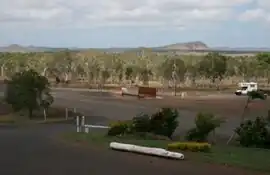 Lakeland Downs | |||||||||||||||
 Lakeland | |||||||||||||||
| Coordinates | 15.8591°S 144.8566°E | ||||||||||||||
| Population | 299 (2016 census)[1] | ||||||||||||||
| • Density | 0.06311/km2 (0.16345/sq mi) | ||||||||||||||
| Postcode(s) | 4871 | ||||||||||||||
| Area | 4,738.0 km2 (1,829.4 sq mi) | ||||||||||||||
| Time zone | AEST (UTC+10:00) | ||||||||||||||
| Location | |||||||||||||||
| LGA(s) | Shire of Cook | ||||||||||||||
| State electorate(s) | Cook | ||||||||||||||
| Federal division(s) | Leichhardt | ||||||||||||||
| |||||||||||||||
Geography
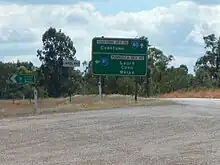
Lakeland is a small farming centre on the Cape York Peninsula. It is at the junction of the main Peninsula Developmental Road (which is paved all the way from Cairns to Lakeland), and the Mulligan Highway (formerly the Cooktown Developmental Road).[4]
An area of basalt in the Lakeland region contains locally significant groundwater supplies which feed numerous springs, and also provides irrigation water and fertile soils for farming.[5]
Lakeland has the following mountains:
- Belle View Peak (15.6644°S 145.0197°E)[6][7]
- Hamilton Peak (16.0381°S 144.8420°E) 664 metres (2,178 ft)[6][8]
- Macdonalds Hill (15.9594°S 144.8498°E) 458 metres (1,503 ft)[6][9]
- Mount Amy (15.9937°S 144.9932°E) 845 metres (2,772 ft)[6][10]
- Mount Byerley (15.6394°S 145.0414°E) 452 metres (1,483 ft)[6][11]
- Mount Earl (15.8833°S 144.9143°E) 469 metres (1,539 ft)[6][12]
- Mount Emily (15.6679°S 145.0675°E) 236 metres (774 ft)[6][13]
- Mount Eykin (15.9505°S 144.9299°E) 571 metres (1,873 ft)[6][14]
- Mount Fahey (15.6849°S 145.0348°E) 242 metres (794 ft)[6][15]
- Mount Gibson (15.9919°S 144.9091°E) 516 metres (1,693 ft)[6][16]
- Mount Herman (16.0663°S 144.7920°E) 636 metres (2,087 ft)[6]
- Mount Janet (15.8959°S 144.7121°E) 703 metres (2,306 ft)[6][17]
- Mount Lukin (15.9131°S 144.6744°E) 764 metres (2,507 ft)[6][18]
- Mount Macdonald (15.6980°S 145.0151°E) 328 metres (1,076 ft)[6][19]
- Mount Mccormack (15.5859°S 144.9771°E) 492 metres (1,614 ft)[6][20]
- Mount Mclean (15.9016°S 144.8387°E) 416 metres (1,365 ft)[6][21]
- Mount Murray (15.9553°S 144.7772°E) 602 metres (1,975 ft)[6][22]
- Mount Pike (16.0259°S 144.9560°E) 842 metres (2,762 ft)[6][23]
- Mount Scatterbrain (15.8686°S 144.9051°E) 426 metres (1,398 ft)[6]
- Mount Sellheim (15.7525°S 144.9581°E) 269 metres (883 ft)[6][24]
- North Sampson Mountain (15.7963°S 145.1741°E) 728 metres (2,388 ft)[6][25]
- Racecourse Mountain (16.0104°S 144.9995°E) 664 metres (2,178 ft)[6][26]
- Shields Sugarloaf (15.7198°S 144.9750°E)[6][27]
- Tandewarrah (15.7190°S 145.1021°E) 474 metres (1,555 ft)[6]
- The Brothers (15.9263°S 144.8526°E) 428 metres (1,404 ft)[6][28]
- The Twins (15.9076°S 144.9162°E)[6][29]
- Three Peaks (16.0718°S 144.8221°E)[6]
- Zillman Peak (16.0578°S 144.8740°E) 688 metres (2,257 ft)[6]
History
_of_Butchers_Hill%252C_Lakeland._Cooktown_and_Laura_River_area%252C_Queensland.jpg.webp)
Yalanji (also known as Kuku Yalanji, Kuku Yalaja, Kuku Yelandji, and Gugu Yalanji) is an Australian Aboriginal language of Far North Queensland. The traditional lands of the Western Yalanji people commence just north of the township of Lakeland and continue southwards past the southern boundary of the locality of Lakeland.[30]
James Earl was granted a lease to occupy pastoral land in March 1877. He named his station Butchers Hill after Butcher Hill Farm in Littleport, Cambridgeshire, England where he lived as a child. It was also known as Turalba Station. The locality was variously known as being in the Cooktown or Laura districts.[31][32] In September 1899 Earl's daughter Sarah Campbell Earl of Turalba Station married Samuel William Wellington Cook, a part owner of the adjacent Spring Vale Station.[33] These two stations comprise the majority of the current locality of Lakeland.
Mining had commenced on the West Normanby Goldfield by the end of 1874.[34] This goldfield should not be confused with the Normanby Goldfield near Bowen, which opened in 1871. Mining continued intermittently, depending on gold prices, until 1999.[35]
The Normanby Diggings Native Mounted Police camp was located on the West Normanby River just south-east of Butchers Hill and operated for 7 years between 1885 and 1892.[36]
The Normanby Reefs Post Office was renamed Earlton (Earltown) Post Office in 1890.[37] It was closed in December 1892.[38][39]
Clive J Foyster was an entrepreneur, mining company chief and farmer who bought Butchers Hill in 1968. In a private venture known as Lakeland Downs development began with the clearing of land intended for agriculture, and two irrigation dams were constructed. Dry land and irrigated cropping commenced with plantings of maize and sorghum and later of peanuts and coffee.[40][41][42] More intensive cattle grazing also commenced. Eventually 70,000 acres (28,000 hectares) were cleared.[43] In the 1980s Lakeland Downs was sold, divided into freehold farms averaging about 990 acres (400 ha). [44][30]
Lakeland Downs is named for William (Billy) Lakeland who was one of the earliest prospectors of Cape York Peninsula.[45][46] The township of Lakeland Downs came into being to service this development, and is now known as Lakeland.[41]
Butcher's Hill State School opened on 23 August 1969. The first teacher was Lorraine Woergoetter. Within two years it had been renamed Lakeland Downs State School.[47][48][40]
In the 2011 census, the locality of Lakeland had a population of 227 people.[49]
In the 2016 census, the locality of Lakeland had a population of 299 people.[1]
Heritage listings
.jpg.webp)
Lakeland has a number of heritage-listed sites, including:
- Mareeba Mining District (15.9776°S 144.9328°E): Nuggety Gully Water Race and Chinese Camp[34]
Economy
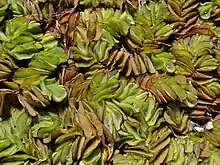
At Lakeland, most of the irrigation water comes from farm dams. Licenses are required to extract surface or bore water for irrigation purposes. In 2012 there were 16 licenses to impound water in the Normanby catchment, with most occurring in the Lakeland area. Many of the dams are located on small creeks. Honey Dam is the largest and is located on Bullhead Creek, which flows into the Laura River. Dams are only permitted to store wet season run off.[51]
The main products are cattle and cropping, including bananas.[52]
Education
Lakeland State School is a government primary (Early Childhood-6) school for boys and girls on the corner of Peninsula Developmental Road and the Mulligan Highway (15.8569°S 144.8568°E).[53][54] In 2018, the school had an enrolment of 17 students with 2 teachers and 4 non-teaching staff (2 full-time equivalent).[55]

There is no secondary school in Lakeland. The nearest government secondary school is Cooktown State School in Cooktown to the north-east. Given the distances involved, distance education and boarding school are other options.[4]
Environmental
The Lakeland Agricultural Area Water Quality Monitoring Program is a project to work with landowners to monitor water quality.[56]
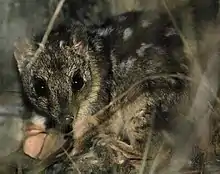
In 2016 the Queensland Government purchased Springvale Station, a 56,295-hectare (139,110-acre) property situated in the east of the locality. Springvale Station was purchased to add to the State’s protected area network and complement activities being taken to reduce sediment run-off entering the Normanby River catchment that flows into Princess Charlotte Bay and the Great Barrier Reef. The Department of Environment and Science contracted Cape York Natural Resource Management (Cape York NRM) to work with Traditional Owners, Griffith University, the Department of Agriculture and Fisheries, and erosion, water quality and vegetation scientists to develop the Springvale Erosion Management Plan.[57][58][59]
Springvale Station Nature Refuge provides important habitat for endangered or vulnerable flora and fauna including the Cooktown orchid, ghost bat, northern quoll, red goshawk, spectacled flying-fox, spotted-tailed quoll, Semon’s leaf nosed bat and large eared-horseshoe bat. There is no public access on the Nature Refuge.[57]
Amenities
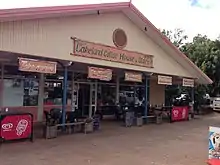
Lakeland has a hotel, a cafe, and roadhouse and a hardware store.
Attractions
James Earl Lookout is off the Mulligan Highway, 14.7 kilometres (9.1 mi) SSE of the town (15.9751°S 144.8289°E).[60]
Transport
Lakeland Airport (YLND) is located north of the township, beside the Mulligan Highway.[61]
References
- Australian Bureau of Statistics (27 June 2017). "Lakeland (SSC)". 2016 Census QuickStats. Retrieved 20 October 2018.
- "Lakeland – town in Shire of Cook (entry 18830)". Queensland Place Names. Queensland Government. Retrieved 19 July 2021.
- "Lakeland – locality in Shire of Cook (entry 46131)". Queensland Place Names. Queensland Government. Retrieved 19 July 2021.
- "Queensland Globe". State of Queensland. Retrieved 22 December 2021.
- "Story Map Series". qgsp.maps.arcgis.com. Physical features. Retrieved 1 March 2023.
- "Mountain peaks and capes - Queensland". Queensland Open Data. Queensland Government. 12 November 2020. Archived from the original on 25 November 2020. Retrieved 25 November 2020.
- "Belle View Peak – mountain in Cook Shire (entry 2177)". Queensland Place Names. Queensland Government. Retrieved 25 November 2020.
- "Hamilton Peak – mountain in Cook Shire (entry 15279)". Queensland Place Names. Queensland Government. Retrieved 25 November 2020.
- "Macdonalds Hill – mountain in Cook Shire (entry 20395)". Queensland Place Names. Queensland Government. Retrieved 25 November 2020.
- "Mount Amy – mountain in Cook Shire (entry 554)". Queensland Place Names. Queensland Government. Retrieved 25 November 2020.
- "Mount Byerley – mountain in Cook Shire (entry 5553)". Queensland Place Names. Queensland Government. Retrieved 25 November 2020.
- "Mount Earl – mountain in Cook Shire (entry 11022)". Queensland Place Names. Queensland Government. Retrieved 25 November 2020.
- "Mount Emily – mountain in Cook Shire (entry 11614)". Queensland Place Names. Queensland Government. Retrieved 25 November 2020.
- "Mount Eykin – mountain in Cook Shire (entry 12096)". Queensland Place Names. Queensland Government. Retrieved 25 November 2020.
- "Mount Fahey – mountain in Cook Shire (entry 12110)". Queensland Place Names. Queensland Government. Retrieved 25 November 2020.
- "Mount Gibson – mountain in Cook Shire (entry 13690)". Queensland Place Names. Queensland Government. Retrieved 25 November 2020.
- "Mount Janet – mountain in Cook Shire (entry 17064)". Queensland Place Names. Queensland Government. Retrieved 25 November 2020.
- "Mount Lukin – mountain in Cook Shire (entry 20256)". Queensland Place Names. Queensland Government. Retrieved 25 November 2020.
- "Mount Macdonald – mountain in Cook Shire (entry 20391)". Queensland Place Names. Queensland Government. Retrieved 25 November 2020.
- "Mount Mccormack – mountain in Cook Shire (entry 21323)". Queensland Place Names. Queensland Government. Retrieved 25 November 2020.
- "Mount Mclean – mountain in Cook Shire (entry 21436)". Queensland Place Names. Queensland Government. Retrieved 25 November 2020.
- "Mount Murray – mountain in Cook Shire (entry 23622)". Queensland Place Names. Queensland Government. Retrieved 25 November 2020.
- "Mount Pike – mountain in Cook Shire (entry 26722)". Queensland Place Names. Queensland Government. Retrieved 25 November 2020.
- "Mount Sellheim – mountain in Cook Shire (entry 30383)". Queensland Place Names. Queensland Government. Retrieved 25 November 2020.
- "North Sampson Mountain – mountain in Cook Shire (entry 24716)". Queensland Place Names. Queensland Government. Retrieved 25 November 2020.
- "Racecourse Mountain – mountain in Cook Shire (entry 27886)". Queensland Place Names. Queensland Government. Retrieved 25 November 2020.
- "Shields Sugarloaf – mountain in Cook Shire (entry 30735)". Queensland Place Names. Queensland Government. Retrieved 25 November 2020.
- "The Brothers – mountain in Cook Shire (entry 33881)". Queensland Place Names. Queensland Government. Retrieved 25 November 2020.
- "The Twins – mountain in Cook Shire (entry 34170)". Queensland Place Names. Queensland Government. Retrieved 25 November 2020.
- "LAKELAND LOCAL AREA PLAN BACKGROUND REPORT" (PDF). Cook Shire Council. August 2017. p. 2. Retrieved 19 February 2023.
- Pike, Glenville (1983). The last frontier. Internet Archive. Mareeba, North Queensland : Pinevale Publications. p. 94. ISBN 978-0-9593785-0-4.
- "THE SKETCHER". The Queenslander. Vol. XLIX, no. 1058. Queensland, Australia. 1 February 1896. p. 213. Archived from the original on 18 February 2023. Retrieved 18 February 2023 – via National Library of Australia.
- "Family Notices". The Northern Miner. Queensland, Australia. 14 October 1899. p. 4. Archived from the original on 18 February 2023. Retrieved 18 February 2023 – via National Library of Australia.
- "Nuggety Gully Water Race and Chinese Camp (entry 600426)". Queensland Heritage Register. Queensland Heritage Council. Retrieved 7 July 2013.
- Denaro, T J (July 2013). Queensland Geological Record 2013/02 Orogenic gold and gold–antimony mineralisation in the Hodgkinson and Broken River Provinces, north Queensland (PDF). p. 19. ISBN 978-1-922067-26-5. ISSN 1039-5547. Archived (PDF) from the original on 18 February 2023. Retrieved 18 February 2023.
{{cite book}}:|website=ignored (help) - "Normanby Diggings [Camp]". FRONTIER CONFLICT AND THE NATIVE MOUNTED POLICE IN QUEENSLAND. 13 December 2016. Archived from the original on 18 February 2023. Retrieved 18 February 2023.
- "Current News". The Queenslander. Queensland, Australia. 22 November 1890. p. 1002. Archived from the original on 18 February 2023. Retrieved 15 February 2023 – via National Library of Australia.
- "Telegraph Department Postal Guide". The Telegraph. No. 6289. Queensland, Australia. 13 December 1892. p. 4. Retrieved 17 February 2023 – via National Library of Australia.
- Wallace, Lennie (2012). The Battlers of Butcher's Hill. Boolarong Press. p. 18. ISBN 978-1-921920-69-1. Retrieved 19 February 2023.
- Wallace, Lennie (2012). The Battlers of Butcher's Hill. Boolarong Press. Appendix. ISBN 978-1-921920-69-1. Retrieved 19 February 2023.
- Wallace, Lennie (2012). The Battlers of Butcher's Hill. Boolarong Press. p. 101. ISBN 978-1-921920-69-1. Retrieved 19 February 2023.
- "Legislative Assembly Hansard 1969 Parliamentary Debates" (PDF). Queensland Parliament. 13 November 1969. pp. 1495, 1496. Retrieved 2 February 2023.
- Pike, Glenville (1983). The last frontier. Internet Archive. Mareeba, North Queensland : Pinevale Publications. p. 2. ISBN 978-0-9593785-0-4.
- "Strategic Business Case. Technical Feasibility Report for Preferred Option. Lakeland Irrigation Area Project" (PDF). SMEC Australia Pty Limited. 27 February 2019. p. 2. Retrieved 19 February 2023.
- "Lakeland and Laura". Cape York and Cooktown. Tourism Cape York. Archived from the original on 19 July 2014. Retrieved 31 July 2014.
- "Queensland Places - Cape York - William Lakeland". State Library Of Queensland. 7 July 2017. Archived from the original on 16 April 2021. Retrieved 22 December 2021.
- Queensland Family History Society (2010), Queensland schools past and present (Version 1.01 ed.), Queensland Family History Society, ISBN 978-1-921171-26-0
- "ArchivesSearch | Queensland State Archives | Queensland Government". www.archivessearch.qld.gov.au. Retrieved 19 February 2023.
- Australian Bureau of Statistics (31 October 2012). "Lakeland (SSC)". 2011 Census QuickStats. Retrieved 31 May 2014.
- "Invasive plants — Cook Shire Council". www.cook.qld.gov.au. Retrieved 3 March 2023.
- Howley, Christina; Shellberg, Jeff; Stephan, Kim; Brooks, Andrew (4 April 2014). "Normanby Catchment Water Quality Management Plan" (PDF). Department of Environment and Science Queensland Government. 3.4.
- "Story Map Series". qgsp.maps.arcgis.com. Economic values. Retrieved 4 March 2023.
- "State and non-state school details". Queensland Government. 9 July 2018. Archived from the original on 21 November 2018. Retrieved 21 November 2018.
- "Lakeland State School". Lakeland State School. 27 March 2020. Archived from the original on 22 December 2021. Retrieved 11 May 2022.
- "ACARA School Profile 2018". Australian Curriculum, Assessment and Reporting Authority. Archived from the original on 27 August 2020. Retrieved 28 January 2020.
- Lister, Ben (21 September 2021). "Lakeland Agricultural Area Water Quality Monitoring Program". Cape York NRM. Archived from the original on 28 October 2022. Retrieved 18 February 2023.
- The State of Queensland, Department of Environment and Science (7 July 2022). "Springvale Station Nature Refuge | Coastal catchment management". Queensland Government. Archived from the original on 16 February 2023. Retrieved 16 February 2023.
 This article incorporates text from this source, which is available under the CC BY 4.0 license.
This article incorporates text from this source, which is available under the CC BY 4.0 license. - One Search (2018). "Springvale Station erosion management plan". State Library of Queensland. Archived from the original on 16 February 2023. Retrieved 16 February 2023.
- Contributed. "Solution at hand for saving Great Barrier Reef". news.griffith.edu.au. Archived from the original on 16 February 2023. Retrieved 16 February 2023.
- "Tourist points - Queensland". Queensland Open Data. Queensland Government. 18 November 2020. Archived from the original on 24 November 2020. Retrieved 24 November 2020.
- "Lakeland Airport - YLND - Airport Guide". AirportGuide. Archived from the original on 14 August 2021. Retrieved 18 February 2023.
Further reading
- Trezise, P.J. 1969. Quinkan Country: Adventures in Search of Aboriginal Cave Paintings in Cape York. A.H. & A.W. Reed, Sydney.
- Trezise, Percy. 1973. Last Days of a Wilderness. William Collins (Aust) Ltd., Brisbane. ISBN 0-00-211434-8.
- Trezise, P.J. 1993. Dream Road: A Journey of Discovery. Allen & Unwin, St. Leonards, Sydney.
- Premier's Department (prepared by Connell Wagner). 1989. Cape York Peninsula Resource Analysis. Cairns. (1989). ISBN 0-7242-6200-8
- Roth, W.E. 1897. The Queensland Aborigines. 3 Vols. Reprint: Facsimile Edition, Hesperian Press, Victoria Park, W.A., 1984. ISBN 0-85905-054-8
- Ryan, Michelle and Burwell, Colin, eds. 2000. Wildlife of Tropical North Queensland: Cooktown to Mackay. Queensland Museum, Brisbane. ISBN 0-85905-045-9 (set of 3 vols).
- Scarth-Johnson, Vera. 2000. National Treasures: Flowering plants of Cooktown and Northern Australia. Vera Scarth-Johnson Gallery Association, Cooktown. ISBN 0-646-39726-5 (pbk); ISBN 0-646-39725-7 Limited Edition - Leather Bound.
- Sutton, Peter (ed). Languages of Cape York: Papers presented to a Symposium organised by the Australian Institute of Aboriginal Studies. Australian Institute of Aboriginal Studies, Canberra. (1976). ISBN 0-85575-046-4
- Wynter, Jo and Hill, John. 1991. Cape York Peninsula: Pathways to Community Economic Development. The Final Report of The Community Economic Development Projects Cook Shire. Cook Shire Council.